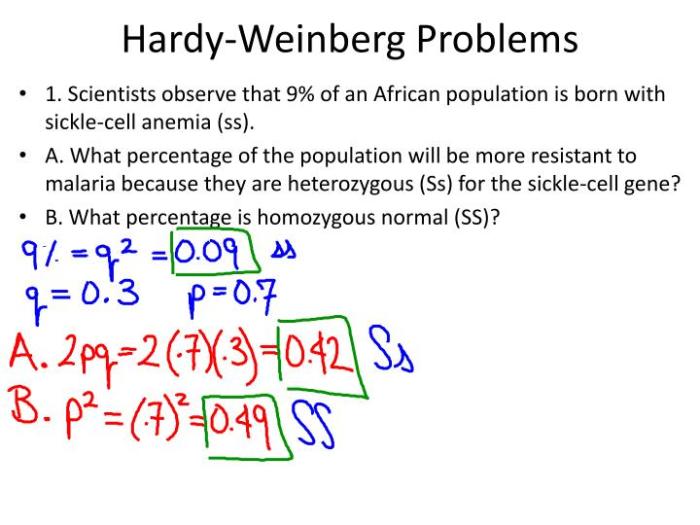Introducing the hardy weinberg problem set mice answer key, a comprehensive guide to unraveling the complexities of population genetics. This resource delves into the fundamental principles of the Hardy Weinberg equilibrium, exploring its significance, assumptions, and limitations. Dive into the realm of allele and genotype frequencies, discovering their importance and methods of calculation.
Understand the concept of genetic equilibrium, the conditions necessary to maintain it, and the factors that can disrupt its delicate balance.
The Hardy Weinberg equation, a cornerstone of population genetics, is presented with clarity, along with its components and applications. Witness the practical implications of the Hardy Weinberg principle in studying genetic diversity and evolution. Engage with a specific example using mice, illustrating the application of this principle and guiding you through the interpretation of results.
Practice problems with detailed solutions and explanations provide hands-on experience, solidifying your understanding of the Hardy Weinberg principle.
1. Introduction to Hardy Weinberg Problem Set

The Hardy Weinberg principle is a fundamental concept in population genetics that describes the equilibrium of allele and genotype frequencies in a population. It provides a theoretical framework for understanding the genetic variation and evolution of populations.
The Hardy Weinberg model assumes a population that is large, randomly mating, and not subject to selection, mutation, gene flow, or genetic drift. Under these assumptions, the allele and genotype frequencies will remain constant from generation to generation.
2. Allele and Genotype Frequencies
Allele frequencies refer to the proportion of each allele in a population, while genotype frequencies refer to the proportion of individuals with each possible combination of alleles.
Allele frequencies can be calculated by counting the number of occurrences of each allele in the population and dividing by the total number of alleles. Genotype frequencies can be calculated using the Hardy Weinberg equation, which will be discussed later.
3. Equilibrium Conditions, Hardy weinberg problem set mice answer key
Genetic equilibrium is a state in which the allele and genotype frequencies remain constant from generation to generation. This occurs when the assumptions of the Hardy Weinberg model are met.
Factors that can disrupt genetic equilibrium include selection, mutation, gene flow, and genetic drift.
4. Hardy Weinberg Equation
The Hardy Weinberg equation is a mathematical formula that can be used to calculate genotype frequencies in a population that is in genetic equilibrium.
The equation is: p^2 + 2pq + q^2 = 1
where p is the frequency of the dominant allele, q is the frequency of the recessive allele, and p^2, 2pq, and q^2 represent the frequencies of the homozygous dominant, heterozygous, and homozygous recessive genotypes, respectively.
5. Applications of Hardy Weinberg Principle
The Hardy Weinberg principle has numerous applications in population genetics, including:
- Studying genetic diversity
- Understanding the evolution of populations
- Predicting the genetic consequences of population changes
6. Mice Example
Consider a population of mice where the fur color is determined by a single gene with two alleles: B (black) and b (white). Let’s assume that the frequency of the B allele is 0.7 and the frequency of the b allele is 0.3.
Using the Hardy Weinberg equation, we can calculate the genotype frequencies:
- BB (homozygous black): 0.7^2 = 0.49
- Bb (heterozygous): 2 – 0.7 – 0.3 = 0.42
- bb (homozygous white): 0.3^2 = 0.09
This indicates that in this mouse population, 49% of individuals are homozygous black, 42% are heterozygous, and 9% are homozygous white.
7. Practice Problems
1. A population of rabbits has two alleles for fur color: A (brown) and a (white). The frequency of the A allele is 0.6. Calculate the genotype frequencies in this population.
2. A population of plants is in genetic equilibrium for a gene with two alleles: D (dominant) and d (recessive). The frequency of the D allele is 0.8. If 100 individuals are sampled from this population, how many are expected to be homozygous dominant?
Query Resolution: Hardy Weinberg Problem Set Mice Answer Key
What is the significance of the Hardy Weinberg principle?
The Hardy Weinberg principle provides a theoretical framework for understanding the genetic makeup of populations and predicting changes in allele and genotype frequencies over time.
What are the assumptions of the Hardy Weinberg model?
The Hardy Weinberg model assumes random mating, no mutations, no gene flow, no genetic drift, and no natural selection.
How can the Hardy Weinberg equation be used to calculate genotype frequencies?
The Hardy Weinberg equation (p^2 + 2pq + q^2 = 1) can be used to calculate the frequencies of homozygous dominant (p^2), heterozygous (2pq), and homozygous recessive (q^2) genotypes in a population.
What are some applications of the Hardy Weinberg principle?
The Hardy Weinberg principle can be used to study genetic diversity, detect genetic drift, identify genetic bottlenecks, and investigate the effects of selection and mutation.

